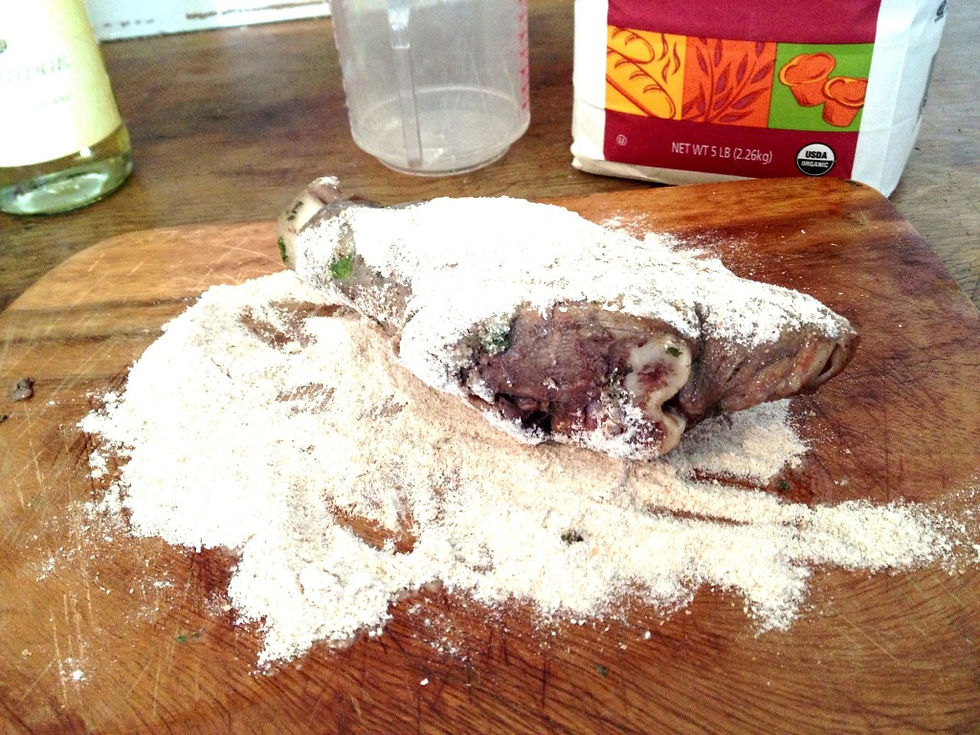Cooking with a Pinch of History: Lamb Shanks with Claret
- anne806
- Mar 29, 2013
- 4 min read
by Brittany Avila
I found this particular recipe in California Mission Recipes and decided on it solely for the self-serving purpose that I LOVE lamb. I cut the original recipe I found into a third, as it calls for 6 lamb shanks, and I wasn’t keen on cooking for a large family. Therefore, I began with 2 lamb shanks and cut down the rest of the ingredients accordingly:
Ingredients:
2 lamb shanks
1 tablespoon of dried celery tops (you can find this in the spice isle of the grocery store, or do what I did and simply use fresh celery tops)
1/3 sprig of parsley, chopped
1/8 tsp thyme
1/3 of a bay leaf
½ to 1 cup of boiling water
¼ cup whole wheat flour
½ cup claret wine (any light, dry wine will do; I used a cheap sauvignon blanc)
1/6 cup olive oil (I used Mission Mills olive oil, SBTHP’s newest product in the shop (for sales info contact our shop manager through the link) pressed from olives grown at the historic Santa Inés Mission Mills! You can find more info about our olives here)
Salt and pepper

Parsley was originally imported to Alta California for use as an herb, spice, and vegetable. Its herbal uses ranged from cooking to medicinal purposes, where it was used to treat gastronomical disorders by grinding the root, stem and seeds into a flour that was then eaten. California Bay Laurel (bay leaf) is a native plant used for flavoring in early California. Photo by Brittany Avila.
Place both lamb shanks and herbs together in a kettle. If you are puzzled by what celery tops are, they are exactly what they sound like. Cut off only the top leaves of the celery stalks if you’re going fresh, or make life easy and simply add your pre-dried celery tops.

Sheep, or borregas, were brought to California during the Portola-Serra expedition. Sheep’s wool was the chief source for clothing and blankets for both Spaniards and neophytes at the missions, but sheep were used secondarily as a meat source. Photo by Brittany Avila.
Because this would’ve been a large iron cast kettle hung over an open fire, I improvised with an iron cooking pan over my stove, since I imagine my landlord wouldn’t be too pleased with an open fire on my porch and I didn’t have a large iron kettle laying around, nor would I know where to purchase one.

The modern day stove top we are cooking on would’ve been replaced by a bracero during Early California, which was a ladrillo, or red tile stove top with stow holes and iron grates to place hot coals in. The bottom portion would’ve been built out of adobe, ladrillo or stone. If you’d like to see a reconstructed bracero, stop by the cocina at El Presidio de Santa Barbara, SHP! Photo by Brittany Avila.
Place the ½ cup of boiling water (boiled in a separate pot) over the lamb shanks and herbs. Let this simmer for one hour. During my cooking venture, I had to add ½ cup more boiling water half way through since most of it had evaporated and I didn’t want the herbs or lamb burning on the pan.
Take lamb shanks off the pan and allow to cool slightly. Then sprinkle with salt and pepper, roll each shank in flour, and sprinkle with salt and pepper again. Because I wasn’t growing and grinding up my own flour as Spanish settlers did (my porch doesn’t make for a good garden), I purchased whole wheat flour to be as close and accurate to the recipe as possible.

Flour was made from Sonoran wheat, which was introduced to California by Spanish missionaries coming from the Sonora region of Mexico. Instead of a factory with specialized heavy machinery, a grinding stone or metate, would’ve been used by early Californians to grind the wheat into flour by hand or “por mano.” The stone used to grind the wheat against the metate was called a mano! Photo by Brittany Avila.
Heat oven to 375 degrees and place lamb shanks in a shallow cooking pan. Place in oven for one hour. Instead of an oven, an horno would’ve been used in Early California, which is a dome shaped adobe structure commonly used to bake bread and other foods. This too can be seen in the cocina at El Presidio de Santa Barbara SHP.
Mix the olive oil and wine together. Baste the lamb shanks with this mixture every 15 minutes. Do not skimp on the basting; the more basting, the more juicy your meat will come out.

Claret was a type of grape introduced to California by the Spanish. Claret and other wines were made by fermenting all of the sugar from the grape. These wines were popular as a lot could be consumed before intoxication. Photo by Brittany Avila.
Take lamb shanks out of the oven after an hour, or when they reach a nice golden brown.
I cut my lamb shanks up and shared with the SBTHP staff, who gave the final product a thumbs up! Lamb mission #1 successfully completed!

The final product! Photo by Brittany Avila.
Sources
Sortomme, Jerry. Plants of Spanish, Alta CA 1764-1834. Rep. N.p.: n.p., October 2011.
Cleveland, Bess. California Mission Recipes. Japan: Charles E. Tuttle Company,1965: 50.
Spiller, Monica. “Sonoran Wheat History: Another Look.” mss (2008): 1-2. Presidio Research Center Vertical Files, “Plants.”
Tays, George. Ranch and Mission Industries in California. Berkeley: n.p., 1941.
Mission San Antonio De Padua Herbs: Medical Herbs of Early Days with Ambrisan, Latin, remedial and common index and glossary. 1974. Presidio Research Center Vertical Files, “Plants.”
Brittany Avila is SBTHP’s Office Manager and is enjoying pursuing her dream to be a maestro de la cocina









Comments